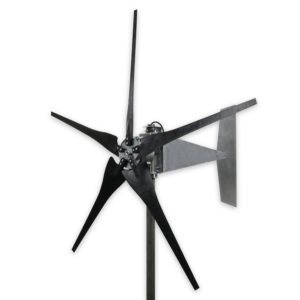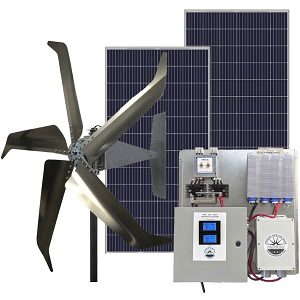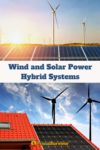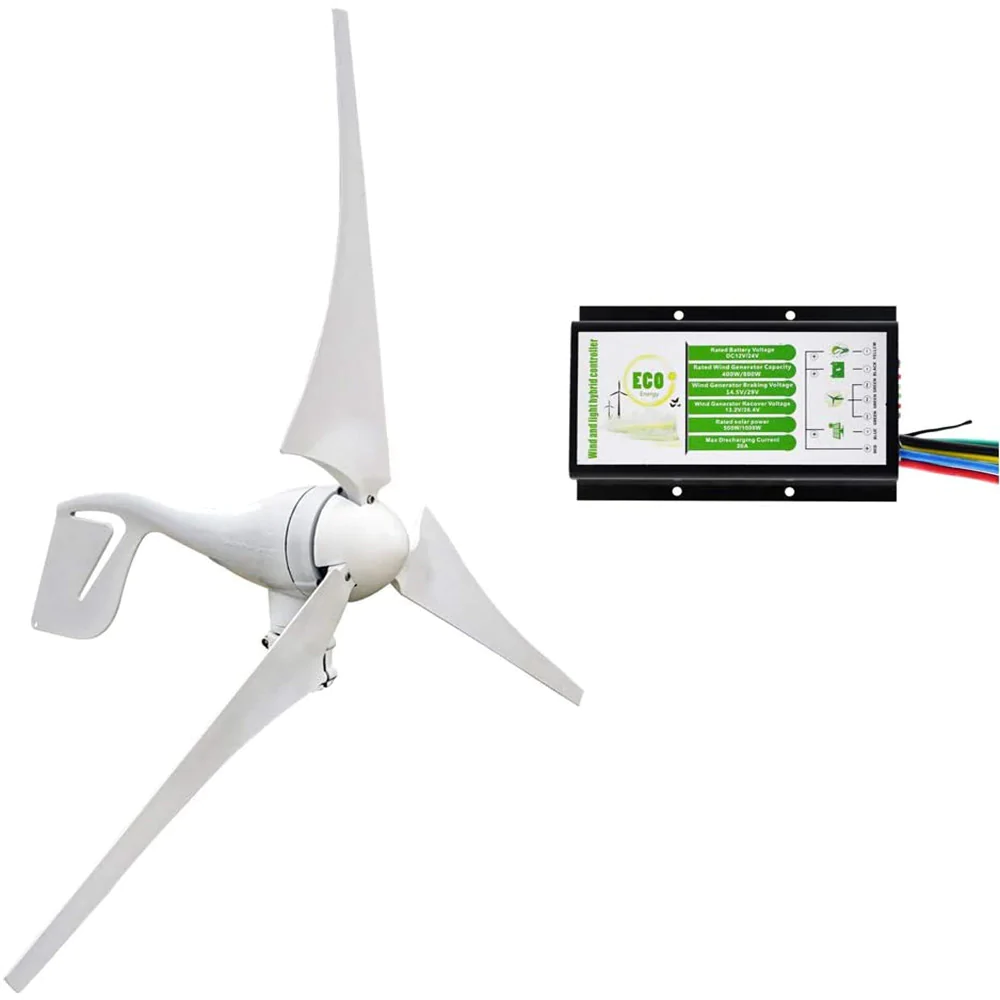When we bought our small-holding 10 years ago, we planned to go off-grid, and now we’re finally ready to take that leap.
We decided against putting all our eggs in one basket; however, opting instead for a hybrid system that uses wind power in conjunction with solar. We hope this approach will provide an uninterrupted power supply throughout the year.
In many parts of the US, wind speeds are negligible in summer, when daylight hours are long.
When winter comes, there’s less sunlight available, and the wind is often stronger.
As a hybrid system utilizes both energy sources, it can provide a more consistent supply than any single source.
What is a Hybrid Wind-Solar Energy System?
A hybrid wind-solar energy system consists of the following components:
- Solar panels
- Wind turbine – see our guide to the best wind turbines
- Charge controller
- Battery bank
- Inverter
- Power distribution panel
These hybrid systems operate off-grid, so you can’t rely on an electricity distribution system in an emergency.
A bank of batteries provides backup power for those wind-still, overcast days, or you can incorporate an existing emergency generator into the system.
This adaptation will make the system more complex, but a good-quality charge controller can operate all three components automatically.
Including the generator in the system also means we can get by on a smaller battery bank.
You can also convert a pre-existing solar system into a hybrid setup by adding a wind turbine and replacing your solar inverter with a hybrid model.
Can You Erect A Wind Turbine In A Residential Area?

Before you set your heart on a hybrid wind-solar energy kit, like this one, however, you should familiarize yourself with the laws governing the legality of wind turbines in residential areas.
Zoning laws may prohibit you from installing a wind turbine in your area, while building-code authorities often limit the height of structures in a residential zone to 35ft.
You would also need to comply with federal legislation restricting noise pollution in residential areas and the US Fish and Wildlife Service’s wind turbine guidelines on protecting migrating and endangered birds.
Pros and Cons of Hybrid Wind-Solar Energy Systems
The advantages of a hybrid wind-solar energy system include:
#1 Consistent Power Supply
With a wind turbine, solar panels, and a bank of batteries, you’ll be one of the few people in the world to have power 24/7, 365 days a year. You’ll have the sun producing energy during the day, the wind generating it at night, and the batteries storing it for up to five days.
#2 Reliable Energy Provision
With a hybrid energy system, you’re hedging your bets. If the sun isn’t shining, you’ve got the wind to fall back on. If that dies, you can turn to your backup generator or battery bank to keep you going. By taking this hybrid approach, you gain an energy system that’s considerably more reliable than the US electric grid.
#3 Device-Friendly Energy Supply
The charge controller within a hybrid solar-wind energy system provides a properly managed and consistent energy flow which isn’t always possible with traditional energy sources.
#4 Minimal Life-Cycle and Running Costs
Renewable energy systems are easy and cheap to maintain. Hybrid energy systems are even more cost-effective as the pressure is shared between the different energy-generating systems.
Every system has its disadvantages, and a hybrid solar-wind energy system is no exception. The negatives of installing a hybrid system include:
#1 Expensive Installation
Although a hybrid energy system will save you money on your electricity bills, the upfront cost is pretty steep. The best hybrid wind-solar systems can cost anywhere between $1800 and $11,000, depending on your energy requirements. In many instances, these prices don’t include batteries or installation.
You can reduce the initial outlay with a US Residential Renewable Energy Tax Credit and offset the remainder with the money you save on your monthly energy bills.
#2 Limited Battery Life
In a hybrid energy system, the batteries are outside and exposed to the elements, and the constant exposure to sun, rain, and wind will inevitably reduce their average life expectancy.
#3 Complex System
With so many different components and a highly sophisticated charge controller, maintaining and monitoring a hybrid solar-wind system requires some knowledge and technical know-how.
Getting Started With a Hybrid Solar-Wind Energy System
Before investing in a hybrid solar-wind energy system, you need a clear idea of your energy consumption.
An energy auditor can do this for you, or you can do it yourself using the resources available online. Energy calculators like this one can help you calculate how much energy you use depending on the appliances you have in your home.
Performing these calculations will also help you identify any areas where you could cut back on your monthly energy consumption, thereby reducing the size – and cost – of the hybrid energy system required.
The next step is figuring out how much wind and sun your home receives so you can establish whether or not it’s sufficient for your needs.
Google’s Project Sunroof can help you calculate the amount of solar power your home could produce based on an analysis of the daily weather patterns and the roof space available.
Establishing how much wind power is available is more challenging. Airports regularly produce wind maps and reports detailing the average daily wind speed in the local area.
A more accurate way of measuring wind power is to fit an anemometer to the top of a mast that’s the same height as your prospective turbine.
Once you know how much energy you use and how much you can potentially generate, you’ll have a much clearer idea of which hybrid wind-solar system is best for you.
A Summary of 3 Popular Wind-Solar Hybrid Systems
#1 Eco-Worthy 24vOff Grid Hybrid System
This adaptable system is ideal for small homes and includes a 400W wind generator. In winds of around 10.5m/s, the wind turbine can produce around 60kWh per month – approximately 10% of the average household’s consumption.
This system also includes a high-quality inverter designed to regulate the power supply and protect your sensitive appliances against surges.
#2 All-in-One Hybrid Wind & Solar Freedom™ Kit

This 24-volt hybrid kit includes two 315-watt solar panels and a high-quality wind turbine. It also comes with two charge controllers to monitor and regulate the power flowing to your batteries.
This affordable kit is also simple to install and operate.
#3 Blue Pacific Solar Hybrid Solar and Wind Kits
Blue Pacific Solar has a range of stand-alone hybrid energy systems available, each of which includes a standard Primus wind generator with a built-in charge controller, a pre-built power center, and a varying number of 300W solar panels.
These pre-wired DIY packages are a bit more expensive than the other kits on the market but simplify the installation process.
Conclusion
A hybrid wind-solar energy system is a solid investment but one that could provide an uninterrupted energy supply all year round. Not only will it save you money on monthly utility bills, but it could prove more reliable than the national energy grid.
Hybrid systems are easily scalable and utilize all the natural resources available, making them sustainable and environmentally friendly.
Installing one in your home could mean that when the rest of the world is plunged into darkness, your home still will be lit up like a Christmas tree.




Hi team I’m in Australia we have a main supply of 240v 1ph or 415v 3ph do you supply and inverter for 240v ac solar wind batteries to suit 20KW system and a ball park figure on the cost delivered to Australia